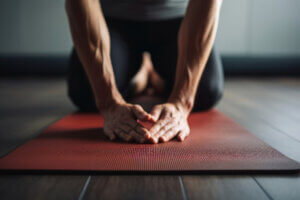Welcome to the ultimate guide on the science of stretching! In this comprehensive resource, we’ll explore the importance of flexibility, the science behind stretching, and how you can incorporate effective stretching techniques into your routine to prevent injury and enhance performance.

Understanding Flexibility and Its Benefits
In this section, we’ll dive into the fundamentals of flexibility and why it’s crucial for overall health and physical performance. We’ll cover the following topics:
- What is Flexibility?: We’ll define flexibility as the range of motion in a joint or group of joints and discuss its significance in various physical activities, from sports to everyday movements.
- The Benefits of Flexibility: We’ll explore the numerous benefits of maintaining good flexibility, including improved posture, reduced risk of injury, enhanced athletic performance, and increased range of motion.
- Factors Affecting Flexibility: We’ll discuss factors that influence flexibility, such as genetics, age, gender, muscle length, and activity level. We’ll also address common misconceptions about flexibility and debunk myths surrounding stretching.
- The Role of Stretching: We’ll introduce the concept of stretching as a fundamental component of flexibility training. We’ll discuss how stretching exercises can help improve flexibility by lengthening muscles and increasing joint mobility.
| Stretching Technique | Description |
|---|---|
| Static Stretching | Involves holding a stretch for a set period without movement. Effective for improving flexibility and range of motion. |
| Dynamic Stretching | Involves moving joints and muscles through a full range of motion. Ideal for warming up before exercise and promoting blood flow to muscles. |
| PNF Stretching | Combines passive stretching with isometric contractions. Effective for enhancing flexibility through neuromuscular facilitation. |
| Foam Rolling | Self-myofascial release technique using a foam roller to target tight muscles and fascia. Helps improve flexibility and reduce muscle tension. |
| Yoga and Pilates | Incorporates stretching, strengthening, and relaxation techniques. Promotes flexibility, balance, and overall body awareness. |
The Science Behind Stretching
In this section, we’ll explore the science behind stretching and how it affects the body at a physiological level. Here’s what we’ll cover:
- Muscle Physiology: We’ll delve into the structure and function of muscles, including muscle fibers and connective tissue. We’ll explain how muscles contract and relax and discuss the role of stretching in maintaining optimal muscle health.
- Stretch Reflex: We’ll discuss the stretch reflex, also known as the myotatic reflex, which is the body’s automatic response to stretching. We’ll explain how the stretch reflex protects muscles from overstretching and maintains muscle tone, and how understanding this reflex can inform our stretching practices.
- Types of Stretching: We’ll explore different types of stretching techniques, including static stretching, dynamic stretching, ballistic stretching, and proprioceptive neuromuscular facilitation (PNF). We’ll discuss the benefits and drawbacks of each type of stretching and when they are most appropriate.
- Effects on Flexibility: We’ll examine how stretching affects flexibility and range of motion. We’ll discuss the mechanisms behind improved flexibility after stretching, including changes in muscle length, joint mobility, and tolerance to stretching sensations.
- Stretching Guidelines: We’ll provide practical guidelines for safe and effective stretching, including recommendations for duration, frequency, and intensity. We’ll discuss the importance of warming up before stretching and the role of proper technique in preventing injury.
Effective Stretching Techniques
In this section, we’ll explore various stretching techniques that you can incorporate into your routine to improve flexibility and prevent injury. Here’s what we’ll cover:
- Static Stretching: We’ll start with static stretching, which involves holding a stretch for a set period without movement. We’ll discuss how to perform static stretches for different muscle groups, emphasizing proper form and breathing techniques.
- Dynamic Stretching: Next, we’ll discuss dynamic stretching, which involves moving joints and muscles through a full range of motion. We’ll explore dynamic stretches for warming up before exercise, as well as dynamic stretches specific to certain sports or activities.
- PNF Stretching: We’ll introduce proprioceptive neuromuscular facilitation (PNF) stretching, a technique that combines passive stretching with isometric contractions. We’ll discuss different PNF stretching methods, such as contract-relax and hold-relax, and how they can enhance flexibility.
- Foam Rolling: We’ll also touch on foam rolling, a form of self-myofascial release that can complement stretching by targeting tight muscles and fascia. We’ll discuss how to use a foam roller effectively and incorporate foam rolling into your stretching routine.
- Yoga and Pilates: Finally, we’ll explore the benefits of yoga and Pilates for improving flexibility and overall body awareness. We’ll highlight key yoga poses and Pilates exercises that focus on stretching and strengthening muscles, as well as promoting relaxation and stress relief.
Building Core Strength: Abs Workouts That Really Work
In conclusion, mastering the science of stretching is essential for maximizing flexibility, preventing injury, and enhancing overall physical performance. Throughout this guide, we’ve explored the fundamentals of flexibility, the science behind stretching, and effective stretching techniques to incorporate into your routine.
By understanding the importance of flexibility and how stretching affects the body at a physiological level, you can tailor your stretching routine to suit your individual needs and goals. Whether you’re an athlete looking to improve athletic performance, a fitness enthusiast striving for better mobility, or simply someone seeking to maintain overall physical health, incorporating regular stretching into your routine can have numerous benefits.
Remember, consistency is key when it comes to stretching. Make stretching a regular part of your exercise routine, and listen to your body to avoid overstretching or causing injury. With patience, dedication, and proper technique, you can unlock your body’s full potential and enjoy the many benefits of improved flexibility.
So, start stretching today and reap the rewards of a more flexible, resilient, and injury-free body. Here’s to your health and well-being!
